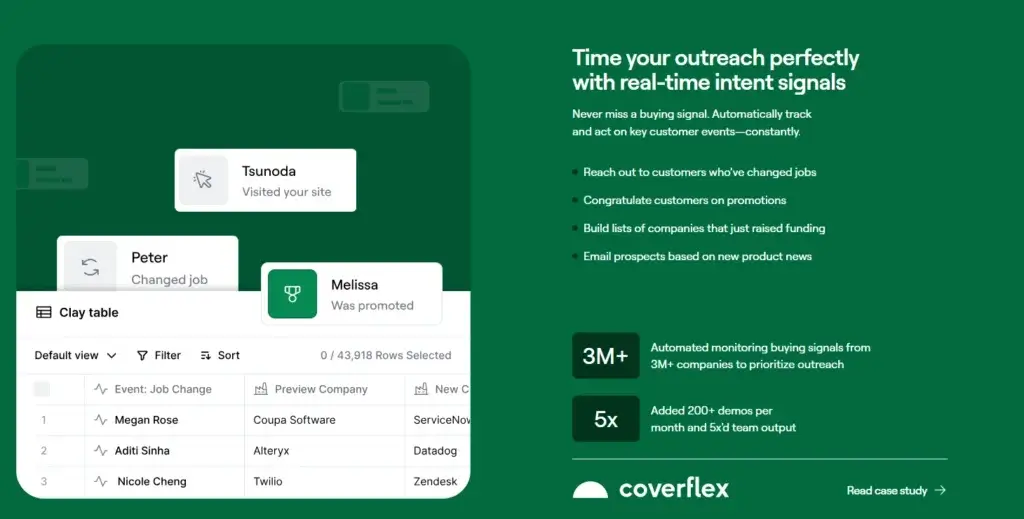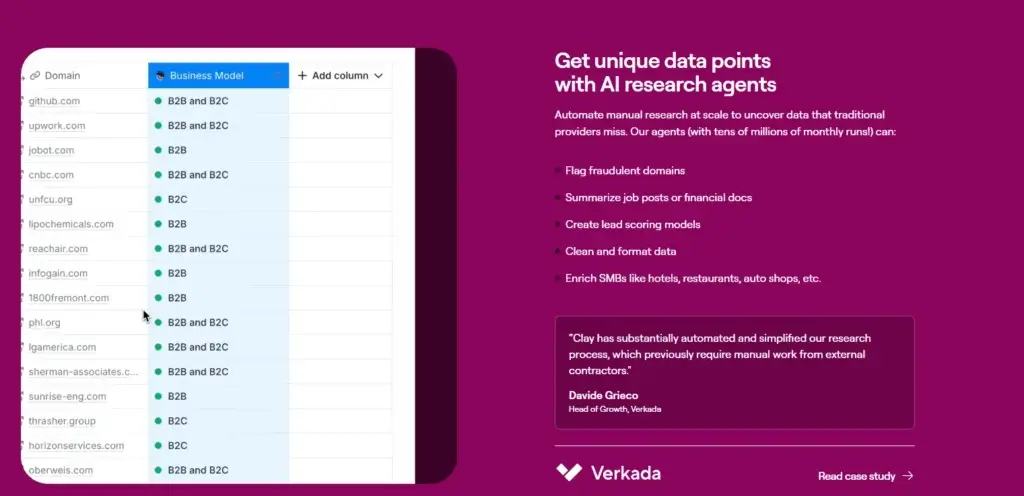Introduction
If you’re spending hours bouncing between LinkedIn, CRMs, and enrichment tools just to build a prospecting list, there’s a smarter way. Clay is reshaping how sales teams handle outreach by bringing AI, data, and personalization into one seamless workflow.
Clay isn’t just another outreach tool. It acts as your AI research assistant, data analyst, and SDR – all in one platform. Whether you’re part of a RevOps team, running outbound for a SaaS startup, or scaling a B2B agency, Clay helps you go from raw lead lists to hyper-personalized emails with just a few clicks.
💡 Think of it as your sales intelligence hub powered by AI.
In this Clay Review 2025, we’ll dive deep into how the platform works, its standout features, real user feedback, and whether it’s the right fit for your team. We’ll also explore pricing, onboarding, and the best alternatives to consider if you’re comparing options.
Here’s what you’ll walk away with:
- A clear understanding of how Clay transforms outbound outreach
- A breakdown of features like AI enrichment, automation, and Claygent agents
- Real pros and cons based on user experience
- Pricing transparency and comparison with top competitors
Let’s explore how Clay can supercharge your sales workflow without drowning you in manual tasks.
What Is Clay?
Clay is an AI-powered sales automation platform that helps you research, enrich, and engage leads at scale.
At its core, Clay is built to reduce the manual grind that sales and growth teams face every day. Instead of jumping between tools to research a company, find contact details, write personalized messages, and sync everything to your CRM, Clay lets you do it all in one place.
🌱 A Brief History
Launched in 2021, Clay started as a data enrichment solution but quickly evolved into something much more powerful. Today, it combines data sourcing, AI research, and automated outreach – allowing you to build highly targeted workflows using natural language prompts or pre-built templates.
Its mission is simple:
Help go-to-market teams spend less time researching and more time connecting.
Who Should Use Clay?
Clay is designed for modern sales teams, but it shines especially well for:
- Outbound SDR teams building cold prospecting campaigns
- Sales ops and RevOps managers seeking data enrichment at scale
- Agencies and freelancers needing custom workflows across multiple clients
- Growth marketers running outreach experiments or managing lead generation
If you’re already using tools like LinkedIn Sales Navigator, Apollo, Hunter, or Clearbit, you’ll find Clay acts as a unifying engine that powers up everything you’re already doing.
What Makes Clay Different?
Rather than replacing your CRM or email tool, Clay works behind the scenes to enhance your workflows. It pulls data from over 50+ public and proprietary sources, enriches it, and then uses AI to personalize messages based on each lead’s context.
You can think of it as a data orchestration layer for sales – combining data, logic, and AI without needing to write code.
🔍 Use case example: Want to find recently funded SaaS startups, identify decision-makers who just got promoted, and email them a personalized message based on their latest blog post? Clay can do that in under 10 minutes.
Key Features
Software Specification
Clay stands out because it doesn’t just give you raw data – it gives you actionable, AI-enriched insights and lets you turn them into personalized outreach at scale.
Let’s break down the features that matter most to modern sales teams 👇
1. AI-Powered Data Enrichment
Clay’s data enrichment engine uses a waterfall model that pulls from over 50+ public and private sources.
This means you get higher match rates, better accuracy, and real-time updates – without juggling 5 different tools.
Here’s what it helps you do:
- Enrich contact and company data with emails, roles, tech stack, revenue, and more
- Monitor intent signals like recent funding, promotions, or job changes 🔍
- Identify buying triggers and use them to personalize outreach
- Build segmented lists based on dynamic attributes
You no longer need to rely on a single data provider. Clay checks multiple sources and fills in the gaps automatically.
💡 Ideal for: SDR teams and RevOps needing reliable, up-to-date lead data.
2. Claygent: Your AI Research Assistant
One of Clay’s most unique features is Claygent, its built-in research agent.
Instead of spending 5–10 minutes manually researching each prospect, you can prompt Claygent to do it in seconds using natural language.
With Claygent, you can:
- Generate lead insights based on company websites, blog posts, and LinkedIn bios
- Summarize job descriptions, product pages, or news articles
- Create enrichment formulas from plain English prompts
- Choose from AI models like Helium, Neon, Argon, or GPT-4
⚡ Want to write a message that references a prospect’s latest podcast appearance? Claygent can find and summarize it for you automatically.
This feature turns Clay from a static enrichment tool into a true AI assistant for sales.
3. AI-Powered Personalized Outreach
Clay doesn’t stop at enrichment – it connects that intelligence to personalised messaging.
You can create AI-generated emails tailored to each lead, using their job title, recent activity, company updates, or tech stack.
Why it works:
- It eliminates the “spray and pray” approach
- Messages feel truly personal, not templated
- Works well with high-volume or ABM campaigns
- Supports dynamic variables and real-time data
✉️ You can integrate these emails into tools like Apollo, Salesloft, or instantly sync them to your CRM.
This dramatically increases reply rates and saves time spent writing hundreds of variations manually.
4. Workflow Automation & CRM Integration
Clay isn’t a CRM – but it plays very nicely with the tools you already use.
It acts as the “middleware” that ties your lead generation, enrichment, and messaging tools together.
Key integrations include:
- HubSpot, Salesforce, Pipedrive
- Outreach, Lemlist, Apollo
- LinkedIn via PhantomBuster or native APIs
- Zapier and Make for workflow automation
🛠️ Build if/then logic like: “If a lead’s company raised funding in the last 30 days, enrich their profile and add them to my warm outbound sequence.”
This kind of intelligent routing helps your sales engine run on autopilot – without losing the human touch.

Pros and Cons
Benefits of Using Clay
Like any powerful tool, Clay has its strengths and its challenges. Whether it’s a game-changer for your team depends on your needs, budget, and technical setup.
Here’s a breakdown to help you decide.
Positive
✅ All-in-One Prospecting Toolkit
✅ Data Enrichment Accuracy
✅ Advanced AI for Personalisation
✅ Deep CRM
✅ Flexible Use Cases
Negative
❌ Steep Learning Curve
❌ Usage-Based Pricing Can Add Up
❌ Not Ideal for Non-Technical Users
❌ CRM Sync Isn’t Always Perfect
✅ Pros
1. All-in-One Prospecting Toolkit
Clay eliminates the need for multiple enrichment, scraping, and messaging tools. It centralizes your workflow, which reduces context-switching and saves hours every week.
2. Impressive Data Enrichment Accuracy
The waterfall model ensures you get the most complete, accurate lead data possible. If one source doesn’t have it, Clay checks another – until it finds the best match.
3. Advanced AI for Personalization
Claygent allows you to write hyper-personalized messages based on public data like blog posts, social profiles, and recent news. This helps your emails feel authentic, not generic.
4. Deep CRM and Outreach Tool Integrations
Clay works well with major CRMs (like HubSpot, Salesforce, and Pipedrive) and outreach platforms (like Apollo and Salesloft). You don’t need to rebuild your entire stack to benefit.
5. Flexible Use Cases
Whether you’re building ICP-based outreach, running cold campaigns, or enriching internal CRM records, Clay adapts to different workflows. It’s ideal for sales, RevOps, and marketing teams alike.
❌ Cons
1. Steep Learning Curve
Clay’s power lies in its flexibility – but that comes with complexity. New users often find the interface and logic setup overwhelming without training or tutorials.
2. Usage-Based Pricing Can Add Up
The credit system is flexible, but it can become unpredictable. If you’re not careful, large workflows can consume credits quickly, leading to higher-than-expected costs.
3. Not Ideal for Non-Technical Users
While you don’t need to code, some workflow logic and AI setup may be difficult for non-technical users. You’ll benefit more if someone on your team is comfortable with data tools.
4. CRM Sync Isn’t Always Perfect
Some users have reported issues syncing with tools like HubSpot or Pipedrive, especially in the lower-tier plans. It’s something to test during your trial.
💡 Bottom line: If your team needs powerful data enrichment and personalized outreach at scale, and you’re comfortable with a bit of tech setup, Clay can be a huge asset. But it’s not plug-and-play like simpler platforms.
User Experience
User Interface and Experience
Clay has gained serious traction in the sales automation world, especially among data-driven growth teams. But what do real users think about it?
We’ve analyzed feedback from G2, Reddit, SaaS communities, and agency reviews to give you an honest picture of the user experience.
What Users Love
Across G2 and community platforms, Clay consistently earns praise for its:
1. Time-Saving Automation
Sales reps report cutting lead research time by 50–80%. Instead of jumping between tabs and tools, everything is handled inside one workflow.
“Clay saves me hours every week. What used to take a full day now takes 30 minutes.” – G2 Review, SDR at a SaaS startup
2. Personalization at Scale
Users love Claygent’s ability to write research-backed messages that feel truly 1:1, not templated.
“We’re seeing 3X higher reply rates since we started using AI-enriched email content.” – Growth Lead on Reddit
3. Versatility for Different Roles
From solopreneurs to RevOps teams, users across different functions find Clay useful. Agencies especially highlight their multi-client use cases.
“It’s the first tool I’ve used that works for both my B2B agency and my productized SaaS.” – Freelancer review on Breakcold.com
Common Criticisms
Not every user experience is perfect. Some of the most frequently mentioned concerns include:
1. Complex Setup
First-time users often describe the onboarding process as steep. Without documentation or templates, it’s easy to get overwhelmed.
“It’s amazing once it’s working, but getting there took me a week.” – Reddit user in r/sales
2. Unpredictable Costs
Because of the credit-based billing, some users were surprised by how quickly credits can be burned through in large workflows.
“Love the product, but we hit our limit in week two – definitely not beginner-friendly on pricing.” – G2 Review
3. Occasional Bugs in Integrations
While Clay offers lots of integrations, users have noted syncing issues, especially with CRMs like HubSpot or tools like LinkedIn.
“Integration with Salesforce was hit or miss. We had to work around it a few times.” – Agency user via G2
🎯 Overall user feedback:
Clay is powerful, flexible, and AI-forward – but it comes with a learning curve and needs a bit of technical patience. For sales teams that value deep personalisation and automated research, it’s a top-tier choice.

Business Size Fit
Clay for Different Business Sizes
Clay is a powerful platform, but it’s not one-size-fits-all. Whether it’s the perfect fit for your team depends on your business size, goals, and how comfortable you are with setting up automation and workflows.
Solo Users & Freelancers
If you’re a solo founder, consultant, or freelancer running outreach on your own, Clay can work – but it might be overkill.
✅ Good fit if:
- You handle high-value, low-volume leads
- You want to automate research-heavy workflows
- You’re tech-savvy and enjoy building custom setups
🚫 Not ideal if:
- You’re sending a handful of emails per week
- You prefer a plug-and-play solution with fewer moving parts
💡 Our View: Only worth it if your deals are high-ticket and you need ultra-personalized outreach.
Small & Mid-Sized Teams
For small sales teams and SMBs, Clay offers excellent value – if you have the bandwidth to build and optimise your workflows.
✅ Good fit if:
- You have a dedicated sales or RevOps lead
- Your team sends 500–5,000 emails/month
- You need custom workflows based on data signals
⚠️ Watch out for:
- Credit usage (costs can add up)
- The initial learning curve for new users
💡 Our View: One of the best tools available for SMBs running personalised, targeted outbound – but train your team first.
Large Sales Teams & Agencies
Clay was practically built for larger teams that want to scale personalisation and data enrichment without scaling headcount.
✅ Great fit if:
- You manage high-volume outreach with complex segmentation
- You run ABM (Account-Based Marketing) or ICP-specific targeting
- You need API access, CRM syncing, and granular controls
Pro tip: Many agencies use Clay as a backend engine – feeding enriched, AI-generated messaging into Apollo, Outreach, or HubSpot.
💡 Our View: Excellent for scaling operations, provided you have someone technical to manage workflows.
Is Clay for You?
Clay is a strong choice if you:
- Run outbound prospecting at scale
- Want to build AI-powered personalization workflows
- Comfortable with some technical setup
- Need deep enrichment and research capabilities
But you might want to explore alternatives if you:
- Only send a few outreach emails per month
- Prefer ultra-simple tools with no setup time
- Have a strict budget and can’t manage usage-based billing
Bottom line: Clay isn’t just a tool – it’s a system. If you’re ready to go beyond templates and dig into smart workflows, it could be exactly what your sales team needs.
Pricing and Plans
How much does Clay cost?
Clay uses a credit-based pricing model, which means you pay for what you use, whether that’s enrichment, AI research, or message generation.
There are four main plans available, ranging from solo users to large sales teams. Each one comes with different credit amounts and features.
Here’s a breakdown of what you get with each plan:
Clay Pricing Overview
| Plan | Monthly Price | Best For | Included Features |
| Free | $0 | Beginners testing Clay | Limited credits, basic enrichment, Claygent access |
| Starter | $149/month | Solo users & freelancers | 1,000 credits, AI outreach, limited integrations |
| Explorer | $349/month | SMB sales teams | 3,000+ credits, advanced enrichment, CRM sync |
| Pro | $800+/month | Agencies & enterprises | High-volume credits, all integrations, priority support |
Key Things to Know:
- Credits are consumed based on tasks: enrichment = 1 credit, AI message = 1–2 credits
- Unused credits don’t roll over from month to month
- Annual billing discounts are available for larger teams
Tip: Start with the Free or Starter plan to test your workflows before scaling up. Clay’s pricing is flexible but can grow quickly based on your volume.
Clay vs Alternatives
How Does Clay Compare To Other Tools?
If you’re exploring tools similar to Clay, you’ll likely come across several popular names in the AI-powered prospecting space. These platforms offer variations in enrichment, personalization, outreach automation, and integrations.
Here’s how Clay stacks up against four major competitors 👇
🔍 Clay vs SmartReach AI vs Apollo AI vs Prospeo
| Tool | Core Focus | Strengths | Weaknesses | Best For |
| Clay | AI enrichment + outreach | Deep personalization, Claygent AI, CRM integrations | Steep learning curve, unpredictable pricing | RevOps, GTM teams, agencies |
| SmartReach AI | Email outreach automation | Easy sequencing, multi-channel, follow-up AI | Weaker data depth, less enrichment control | Cold email teams & agencies |
| Apollo AI | Lead database + outreach | Large contact pool, all-in-one tool, built-in dialer | Less flexible, templated messaging | High-volume outbound SDR teams |
| Prospeo | Behavioral outreach AI | Smart triggers, job change alerts, quick campaigns | Shallow enrichment, limited logic | Growth teams, product-led sales |
| RocketReach | Contact lookup | Fast, simple UI, accurate emails | No automation, no personalization | Recruiters, solo users, fast prospecting |
Clay vs SmartReach AI
SmartReach AI is built for automated outreach first, while Clay is centred around data enrichment and research.
Use SmartReach AI if:
- You want multi-channel outreach (email, LinkedIn, WhatsApp) out-of-the-box
- Your team values AI email writing and auto follow-ups more than data depth
- You need easy-to-use sequences without heavy setup
Choose Clay if:
- You need in-depth lead enrichment and personalisation at scale
- You want to integrate enriched data into existing CRM or outbound tools
- Your team runs complex targeting logic or account-based workflows
📌 Best for: SmartReach is better for teams focused purely on email outreach automation. Clay is better for data-heavy, research-first workflows.
👉🏼 Read our Full SmartReach AI Review or visit SmartReach AI directly
Clay vs Apollo AI
Apollo AI offers both data and outreach, but it’s built for volume over depth.
Use Apollo AI if:
- You want an all-in-one platform with enrichment, email, dialer, and sequences
- Your team needs large contact databases with simple filters
- You’re okay with more template-based outreach vs. ultra-personalized messages
Choose Clay if:
- You need custom enrichment logic and waterfall sourcing
- You rely on AI agents like Claygent for deep research
- Personalization and smart workflows are more important than scale
📌 Best for: Apollo wins in high-volume outbound. Clay wins for quality and smart prospecting workflows.
👉🏼 Read our Full Apollo AI Review or visit Apollo AI here
Clay vs Prospeo
Prospeo focuses on AI-generated messaging based on lead behavior and job changes.
Use Prospeo if:
- You want behavioural signals (like job switch or LinkedIn activity) to trigger campaigns
- You need smart triggers for engagement timing
- You prefer lightweight enrichment with a heavy focus on sending
Choose Clay if:
- You want more control over enrichment formulas and data sources
- You need rich integrations and logic-driven workflows
- You care more about research depth than signal-based automation
📌 Best for: Prospeo is ideal for signal-based messaging. Clay wins for multi-source enrichment and AI-driven prospect research.
👉🏼 Read our Full Prospeo Review or visit Prospeo platform here
Clay vs RocketReach
RocketReach is a contact lookup tool first, with limited automation or AI personalization.
Use RocketReach if:
- You only need accurate contact information fast
- You’re looking for a no-frills email finder tool
- You prefer simple UIs over workflow automation
Choose Clay if:
- You need intelligent workflows with research, enrichment, and messaging
- You want to personalise outreach at scale using AI
- You need to build entire pipelines based on ICP rules and triggers
📌 Best for: RocketReach is for quick, simple prospecting. Clay is better for strategic, AI-assisted outbound programs.
👉🏼 Read our Full RocketReach Review
Conclusion
Final thoughts
Clay isn’t just another AI sales tool – it’s a full-scale prospecting and personalisation engine built for modern, data-driven teams. If your outbound strategy depends on timing, relevance, and deep research, Clay gives you the power to scale it without sacrificing quality.
From real-time enrichment to AI-generated outreach, it combines the flexibility of a spreadsheet with the intelligence of an SDR team – but in software form.
🎯 Here’s what stands out:
- Claygent helps you generate insights in seconds, not hours
- Waterfall enrichment pulls the best data from 50+ sources
- CRM and outreach integrations let you connect workflows end-to-end
- Credit-based pricing gives you control – though it requires planning
But it’s not a magic bullet. Clay takes time to set up, and there’s a learning curve. It’s best suited for teams that think strategically about outbound and want more control over the sales process.
📝 Final Recommendation
- Choose Clay if you need AI-powered enrichment, outreach automation, and smart workflows to scale your sales ops.
- Consider an alternative (like SmartReach or Apollo) if you need simpler, lower-maintenance tools or if your focus is purely on volume.
💡 If you’re serious about building intelligent outbound systems and are ready to invest in setup and optimization, Clay is one of the best tools on the market.
Ready to give it a try? Start with Clay’s free plan or explore their templates to see how it fits into your workflow.
Have more questions
Frequently Asked Questions
1. What is Clay used for?
Clay is an AI-powered sales tool that helps you enrich leads, research prospects, and automate personalized outreach using real-time data and GPT-based AI agents.
2. Is Clay a CRM?
No, Clay is not a CRM. It’s a data orchestration and outreach platform that integrates with your existing CRM (like HubSpot or Salesforce) to enhance your workflows.
3. How does Claygent work?
Claygent is Clay’s AI assistant. It uses large language models to research leads, summarize web content, and help you personalize messages based on real-time insights.
4. What data sources does Clay pull from?
Clay uses a waterfall enrichment model with 50+ public and proprietary sources, including LinkedIn, company websites, Clearbit, Crunchbase, and job boards.
5. Can I use Clay for cold email?
Yes. Clay can generate personalized cold emails using GPT and enriched data. You can export these into tools like Apollo, SmartReach, or Lemlist for sending.
6. How much does Clay cost?
Clay’s plans range from free (with limited credits) to Pro plans at $800+/month. Pricing is based on usage credits consumed by enrichment and AI tasks.
7. Who is Clay best suited for?
Clay is ideal for GTM teams, SDRs, agencies, and RevOps teams who need advanced enrichment, data automation, and personalized outreach at scale.
8. Does Clay integrate with HubSpot and Salesforce?
Yes, Clay integrates with both. You can sync enriched leads, update records, and trigger workflows based on specific conditions within your CRM.
9. What are the downsides of using Clay?
The main challenges are the steep learning curve, potentially high costs with large workflows, and occasional sync issues with some integrations.
10. What’s the best alternative to Clay?
If you want simplicity and focus on email outreach, SmartReach AI is a strong alternative. For all-in-one solutions, Apollo AI is popular. For behavior-triggered messaging, consider Prospeo.







